You know why your business needs a presence on Facebook today. And you also know that it can be tough to cut through the noise and find your target audience through Facebook.
Organic reach on Facebook is almost dead, but Facebook's algorithm has got a way out for this, and that's Facebook groups for businesses.
Facebook groups offer an excellent opportunity for businesses to connect with like-minded people and have meaningful discussions by creating a sense of community (and that too without running ads.)
If you want to further dig deeper into how a Facebook group for businesses can be enriched, this guide is precisely the place for you. So keep reading!
- Facebook Page Vs. Group For Business: Which One Should You Opt For?
- Facebook Groups Types
- How To Create A Facebook Group For Business?
- How To Add Admin To Facebook Group?
- How To Select Business Group Names For Facebook?
- Facebook Group Rules
- How To Grow Your Facebook Group For Business?
- How To Post In A Facebook Group?
- How To Delete A Facebook Group?
- Briefly Put
You can directly jump to a section of your choice or keep scrolling.
Click here to download detailed infographic on tips to grow your Facebook group for business.
Facebook Page Vs. Group For Business: Which One Should You Opt For?
A Facebook page (also known as a Fan page) is managed only by the administration of the page. The admins can share captivating content on their page, and the fans of the page (who follow the page) will receive updates as to when new content is posted. They can interact with the page by dropping comments on the post.
On the other hand, Facebook groups are collaborative in nature. It's created for people sharing common interests to voice out their opinions. Facebook groups unite people by a common cause, purpose, or activity.
Facebook groups are managed by communities and designed to enable the group members to interact and engage with each other. Group admins can create posts, pin important posts to the top of the timeline, and have the responsibility to review group member’s posts.
When it comes to creating an online presence, groups can be more beneficial to businesses. They are perfect for sharing ideas and foster teamwork. If you want to create a community that can connect with each other and discusses matters of common interest, a group is the best option. Most businesses create Facebook groups to promote their brand and build a network of potential customers.
Related: Should You Create A Facebook Group For Your Business?
Facebook Groups Types
Since the Facebook Communities Summit was held on October 01, 2020, Facebook offers two types of groups to be created on its platform.
1. Public Facebook Group
It is an open group type where anyone can find your public group upon searching.
It allows anyone to be a part of the group. If you want, you can put up a set of screening questions for the potential members to answer. This can serve as your basis to know if the Facebook user who wants to join the group is a real person and not just a bot.
Anyone who is not a part of your group can see your group content. They will also be able to see a list of your group members and the admins/moderators.
Admins have control over who can post in public groups. Anyone can engage with posts on your public Facebook group. The admin of a public Facebook group can control who will engage in the public groups.
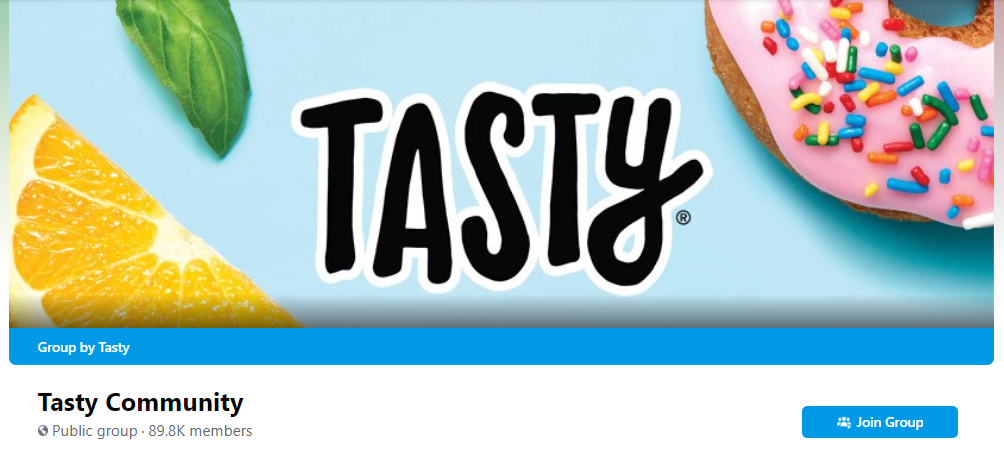
Image Source: Tasty Community Facebook Group
Pros Of Public Facebook Groups
Increasing the visibility of your Facebook group as people who are not members of the group also have the option to share posts, thus spreading the word about your group.
Content posted in your public group has a wider reach and impact. Use relevant hashtags in your public group post to maximize the content reach and increase the visibility of your Facebook group.
Cons Of Public Facebook Groups
Requires tight moderation as anyone can easily join the group, there arises a possibility of potential spammers joining the group and sharing irrelevant posts.
2. Private Facebook Group
If you want to keep your group as a niche community, then a private group would be a suitable option. Those who wish to be a part of your private group will send out a request to join so you can allow those people in your group who are suited to be part of the community you desire to create.
The content inside your private group will remain secret and is only discoverable by the members of your group. You can still screen your private Facebook group members based on the questions you ask them to answer while requesting to join the group.
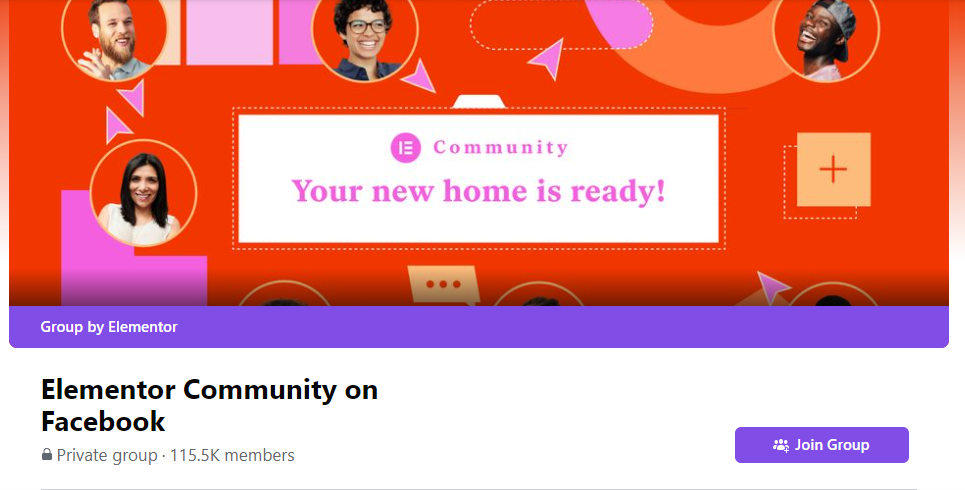
Image Source: Elementor Facebook Group
If you want your Facebook group for business to be a private one, you will have to choose between one of the two visibility options.
1. Visible
Anyone would be able to find your group in search and other places on Facebook.
2. Hidden
Only members of your group would be able to find your group in search and other places on Facebook. This is a favorable option for groups meant for members who are paying for subscriptions in your business.
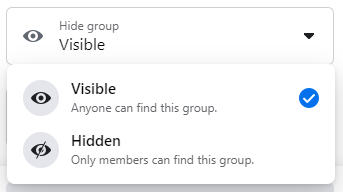
Note: The visibility option for public groups is visible by default (and cannot be changed to hidden). If you have to make your public group hidden, you would have to change its privacy setting from "Public" to "Private."
Pros Of Private Facebook Groups
Less probability of spammers joining the group as those interested in joining will have to send a request to join and answer a few questions. The admin or moderator can scan their profiles and review their answers before allowing them to join, view, and share posts on it.
Personal information can be shared within a private group as conversations happening inside a private group are only visible to members of the group.
How To Choose The Facebook Group Type For Your Business?
If you want to have general conversations concerning your business and niche, go for a public Facebook group.
If you want a tight-knit community where members can share their personal stuff, then opt for a private Facebook group.
How To Create A Facebook Group For Business?
- Login to your brand's Facebook account. From the left side of your feed, select "Groups."
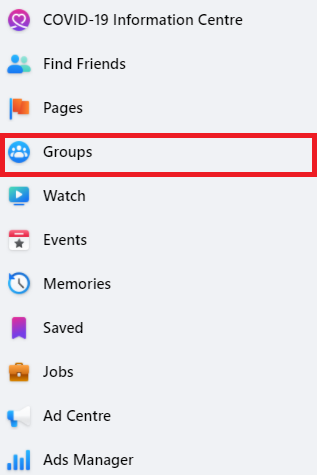
- From the options opened up, select "Create New Group."
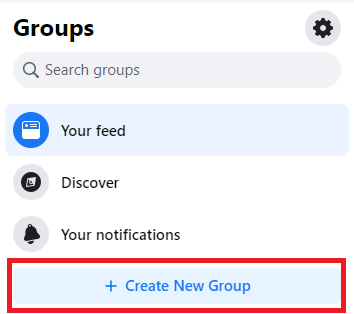
- On the left-hand side of the page, you will have to fill in information like selecting a group name and choosing the privacy setting to complete creating the group.
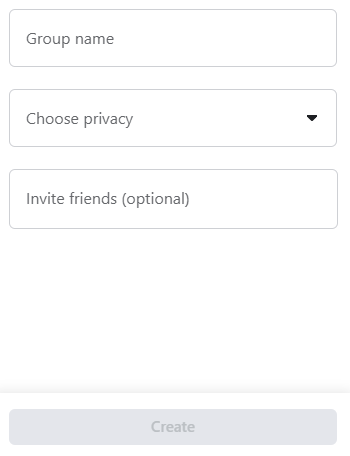
You can also invite your friends to join your newly created Facebook group for business, but this is optional.
If you select the privacy settings as "Private," you would have to choose the visibility option for your private group amongst the two.
- Now, you are all set to click on "Create" to complete the creation of your Facebook group for business.
How To Add Admin To Facebook Group?
As the Facebook group for your business starts to grow, the discussions would grow, members would clash inevitably, and there would be enormous demands for your attention. You would require more people to manage the group activities efficiently (especially if it's a public group.)
Having enough admins and moderators will keep things from getting out of hand and ensure that the group rules are maintained and followed by all group members. Admins will ensure that group questions are answered promptly and professionally and that conversation keeps flowing in the group.
To learn the difference between admin and a moderator in a Facebook group give a read to the Facebook’s guide from here.
Before getting to know how to add an admin to a Facebook group, keep in mind the following points.
- You can only add admin when you are already the admin of a group.
- A user must be a member of your group to make them an admin. If a user is not an existing member of your Facebook group, you can invite them to be a member of your group to add them as an admin.
- You won't be able to make a member of your group an admin if they haven’t given permission in their Facebook privacy setting.
- You won't be able to make someone your group admin either if they have joined too many Facebook groups.
- Your Facebook group can have 5 admins at a time.
Once you have confirmed these points, you can easily proceed to these steps to make someone (and also a trusted person) an admin of your Facebook group.
- Open your Facebook business group. Under your Facebook group name, click on "Members."

- Under the "Admins & moderators" section, scroll to the member of your group whom you want to make an admin. Click on the three horizontal dots next to the selected member's name.

- From the pop-up menu opened, select "Add as admin."
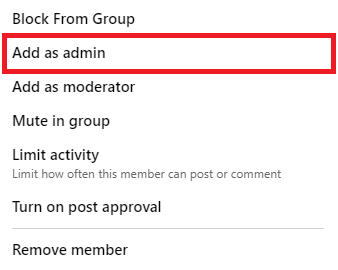
- A dialog will open saying that if the member accepts your invitation to be the group's admin, they can get full permission to edit the group setting, add and remove group members, and give other group members admin status. Once you click on "Send Invitation," you will have to wait for the member to confirm your invite.
How To Select Business Group Names For Facebook?
Your Facebook Group name is perhaps the first element that a potential member will see once they land on your group. Keep the following points in mind while selecting the perfect business group names for Facebook.
- Include the name of your business, product or service so that it becomes easily relatable for your customers.
- It should be understandable and easily relatable to your audience the moment they read it.
- It should include the keywords so that Facebook starts showing your group in suggestions to people who search for similar keywords.
- It should be a combination of who the group is for, what the group is about, and why people should join your group.
Facebook gives you only 75 characters to express the above points in your business group name.
How To Change Facebook Group Name?
If you decide to change the Facebook group name of your business, you can do so after every 28 days. Every time you change your Facebook group's name, your group members will receive a notification. Also, the change will be reflected in the group's name history.
Follow these steps to change the Facebook Group name of your business.
- Open your Facebook group page. On the left-hand side of the page, select "Settings" under the "Activity and insights" section.
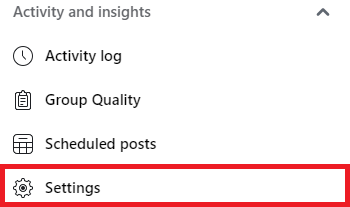
- Click on the pencil icon against "Name and description" under the "Set up group" section.
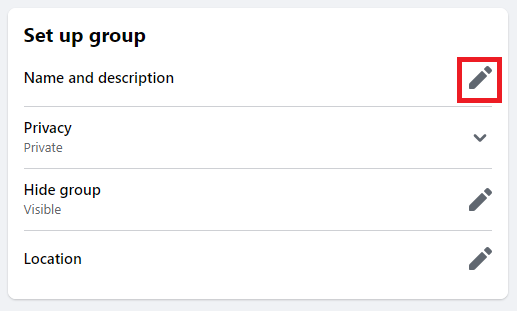
- Now you can change your Facebook group name to your liking. Once you are done, hit Save.
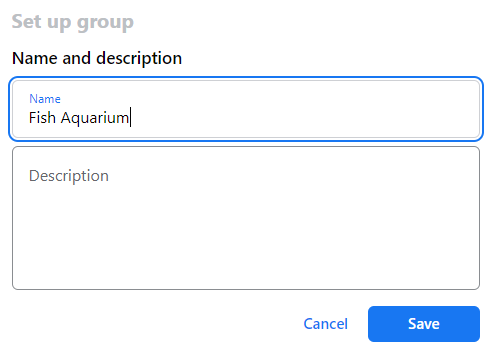
Facebook Group Rules
Without Facebook group rules, the quality of content in the group will suffer, and the discussions would not be proceeding in any direction. Establishing clear rules for your Facebook group for business will keep things civic and productive.
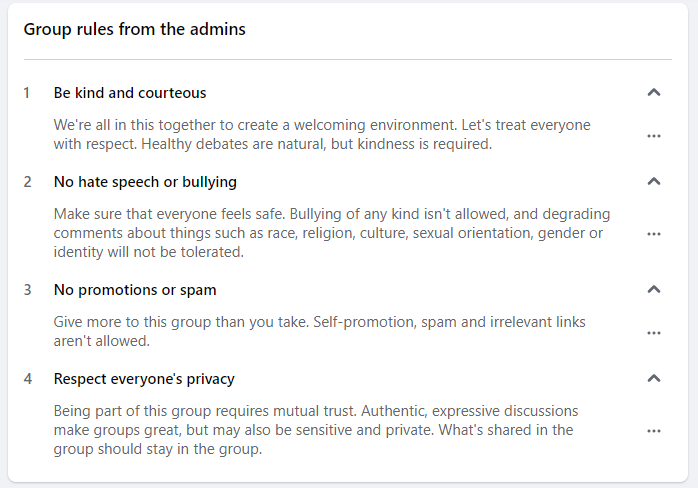
Image Source: Kids Nutrition and Recipes Facebook group
Put some guidelines in place for the type of content to be posted and shared on the group. Avoid any kind of content related to self-promotion as these would not be leading to any meaningful conversations in your group.
Groups without specific rules are rarely successful as they end up becoming a spammers fest. A set of predetermined rules will set clear expectations for all group members. It will also set the tone for the overall group culture.
It's also essential that your group rules are clearly visible to all group members and new members who wish to join. Hence, include these rules in your group discussions or create a post and pin it to the top of your group.
Here are the most common rules that most successful Facebook groups should include.
- Be respectful
- Be helpful to all group members by answering their questions if you can
- Post only relevant content
- No self-promotion
- Before posting a question, check if it has already been answered earlier
Learn about how to create and delete Facebook group rules from here.
How To Grow Your Facebook Group For Business?
Well, creating a Facebook group for business is pretty easy, but building and maintaining a thriving community is the challenging part. Here’s what you need to know and do to grow your business Facebook group.
Your Group Is Not About You
Facebook groups for business are usually started with the purpose of selling products but never make this the main focus of your group discussions. Give space to your users to share their problems and allow others to come up with a solution. Then strategically pitch your products or services only to those who express their problem.
Create Exclusive Content
Facebook groups for business have endless possibilities of sharing content. But your content should be created with your group members in mind. It should provide a reason for them to keep coming back and engage with your content.
Be A Conversation Starter
Keep your Facebook group for business alive by posting regularly, engaging with group members, and encouraging conversation within the group. If a group member (especially new ones) shares their first comment or post, encourage them by responding and liking their post so that they feel acknowledged and appreciated.
Organize Giveaways
Giveaways not only keep your current group members coming back, but they also allow new members to join in because no one wants to be left out of winning something. By spreading the word about your giveaway, you can encourage new people to join, thus increasing your brand and business visibility.
How To Post In A Facebook Group?
The key to an awesome Facebook group for business is engagements. And you will get engagements only if you deliver value to your audience through content. In this manner, you will be able to provide value by sharing relevant information through posts.
Learn how to post in a Facebook group using these two methods
- If you have newly created your Facebook group, you will be able to see an option to "Create post" on the right-hand side of your Facebook group page.
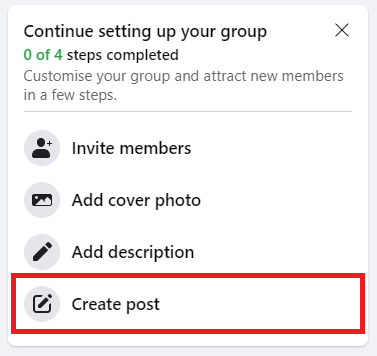
- You will also be able to see a box to create posts next to your profile picture near the top of your group page.
Once you select the three black vertical dots, you can find all of the available post formats.
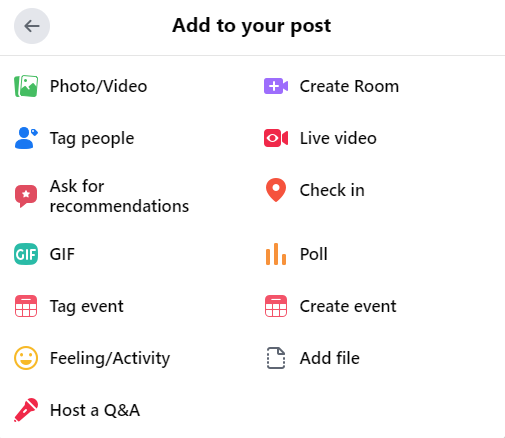
After you are done creating your desired post, you need to click on "Post" to share your post with the rest of your group members.
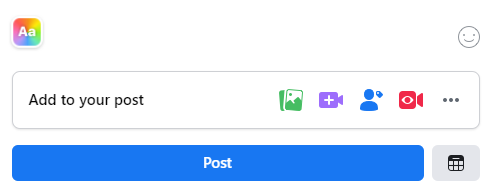
How To Make A Post-Shareable On A Facebook Group?
Can You Make A Post-Shareable On A Private Facebook Group?
Posts in private groups exclude the "share" option to prevent sharing another member's private information.
Have you ever come across a post on Facebook where it said "Attachment Not Available"? That's because the original post was from a private group, so the content is hidden.

The private group setting is chosen for a higher level of privacy for the group members. Only the private group members can see what other group members have posted.
How To Make A Post-Shareable On A Public Facebook Group?
Public Facebook groups allow the members and non-members of your group to share posts put up in your group to increase its reach. After all, that's the core purpose of a Facebook public group: to increase the reach and visibility of your group content and, eventually, your group.
You can share any post from your public Facebook group by clicking on the "Share" option under the already posted content.
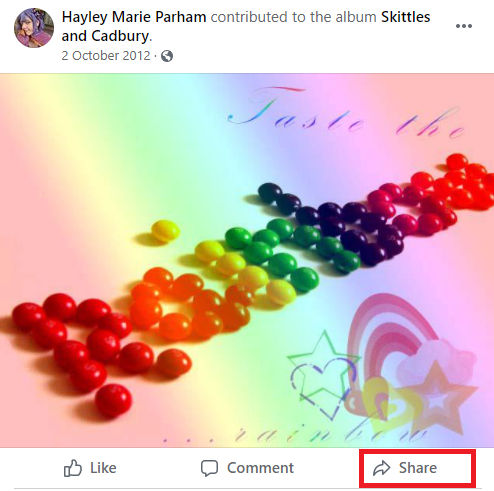
Image Source: Skittles vs Cadbury Facebook Group
Once you click on "Share," several sharing options will be opened up like the ones shown below.
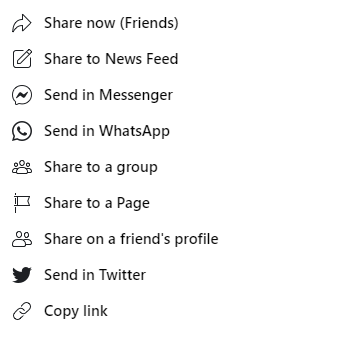
How To Post Anonymously On Facebook Groups?
Facebook does not allow anonymous posting for all groups. Group admin can choose whether or not to allow anonymous posts in their group.
Once someone submits a post anonymously, it goes to the group admin for approval. Anonymous posts require the admin's approval before being posted, even if the post-approval hasn't been turned on for the group.
Learn how you can allow anonymous posting on our Facebook group.
-
Open your Facebook group page. On the left-hand side of the page, select "Settings" under the "Activity and insights" section.
-
Click on the pencil icon against "Anonymous posting" under the "Features" section.
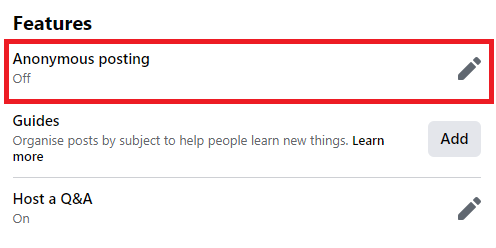
- The dialog that will open up will show the rules of Anonymous posting on Facebook groups. Below these rules, there will be an option to turn on anonymous posting. Once you are done, hit “Save.”
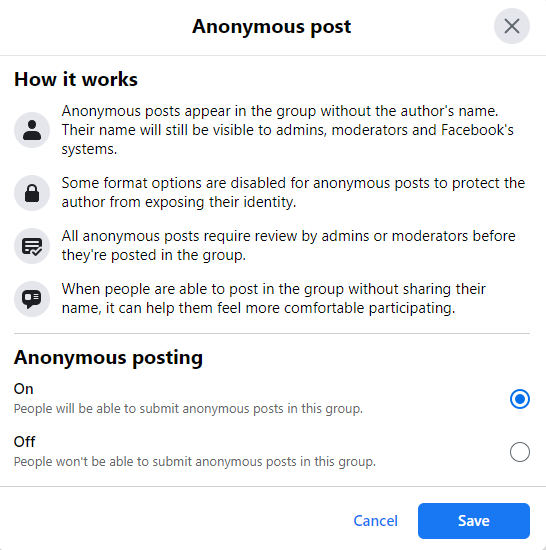
If your group allows its members to post anonymously, then learn how to post anonymously on Facebook groups using these steps.
- Open your Facebook group, and you would be able to see an "Anonymous post" option while putting out a post.

- After you click on "Anonymous post," the rules of posting anonymously in a Facebook group will be displayed in a dialog.
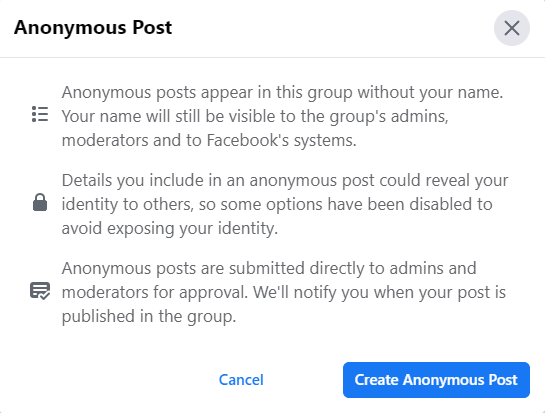
- Once you click on "Create Anonymous Post," you will be able to draft your anonymous post. Click on "Submit" after you're done, and your post will go to the group admin for approval.
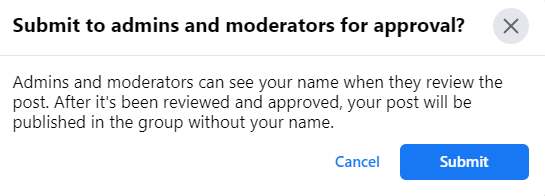
Note:
- Admins and moderators don't need the approval to post anonymously on Facebook groups.
- If someone in your group chooses to post anonymously, their name will still be visible to the group's admins and moderators.
- Some post formats are disabled for anonymous posts to protect the member from inadvertently exposing their identity.
How To Pin A Post On Facebook Groups?
If you want to utilize your Facebook group for business needs, pinning posts is an excellent opportunity. You can pin posts related to your business, product, and services so that they remain at the top of our Facebook group's timeline.
If anyone enters your Facebook group, they would first go through pinned posts and then the remaining group discussions. Pinning posts also increases the visibility of the post, which you find to be most valuable for your group.
However, posts in Facebook Groups cannot be pinned as easily as they are done on pages. As a group admin or moderator, you will first have to make an announcement in your group like this.
You need to click on the three horizontal dots at the top of a post in your group. From the menu opening, you will have to select "Mark as announcement."
Announcements also appear at the top of a Facebook group's timeline, and you can have up to 50 announcements at a time.
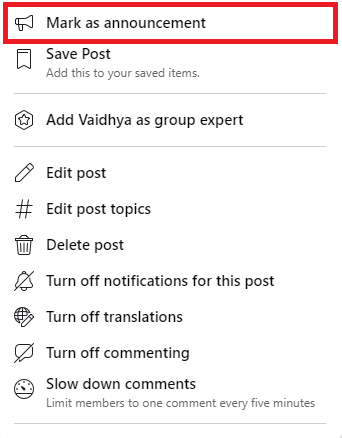
Facebook has an entire section for announcements of groups which can be found below the group's name.

To pin a post, locate to the announcement section in your Facebook group. Select the three horizontal dots from the top of the post which you desire to pin. From the menu opened, click on "Pin to top," and you are done pinning a post in your Facebook group.
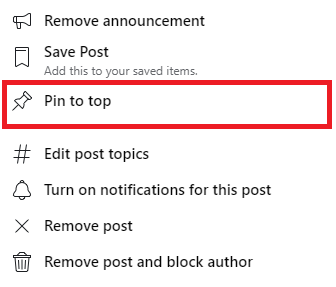
Note: Only admins and moderators can make an announcement and pin post in Facebook groups.
How To Delete A Facebook Group?
If, at some point in time, you realize the purpose with which you created the group was not being served, you can choose to delete a Facebook group. However, you need to be extremely careful about this decision as this action is permanent and irreversible.
You can delete a Facebook group only after you have removed all your group members. To perform this action, go to the "Members" section under your group name. Click on the three horizontal dots beside each group member's name, and select "Remove member" from the menu opened.
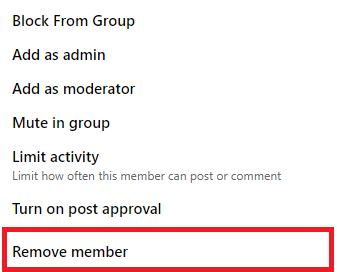
Once you have removed all members from your Facebook group, you have to remove yourself by clicking on the three vertical dots beside your name and selecting "Leave group."

After you click on "Leave Group," Facebook will ask you for a confirmation to leave the group as the group will be permanently deleted since you are the last member left in the group. Once you click on “Delete group,” your Facebook group will be permanently deleted and won’t be visible to anyone (if you had created a public or private visible group.)
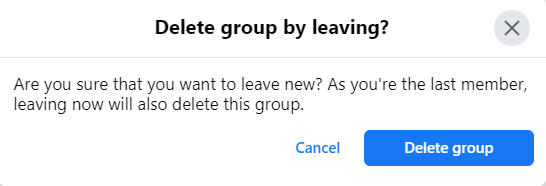
Note:
- You can delete a Facebook group if you are an admin but didn't create the group only if the original creator of the group has left it.
- Your group members won't be notified if you choose to delete a Facebook group.
Briefly Put
The best thing you can do today for your business is building a loyal community of your customers.
A Facebook group for business will keep your existing audience engaged while also attracting new customers. Get involved in discussions with your customers, and you never know when you will end up with some new ideas for your next product or service based on their feedback!
Statusbrew is a social media management platform that integrates all your social media efforts to help you run seamless social media campaigns, track engagement, and derive analytical reports.
Statusbrew is an all-in-one social media management tool that supports Facebook, Instagram, Twitter, Linkedin, YouTube, and even Google My Business.
Infographic
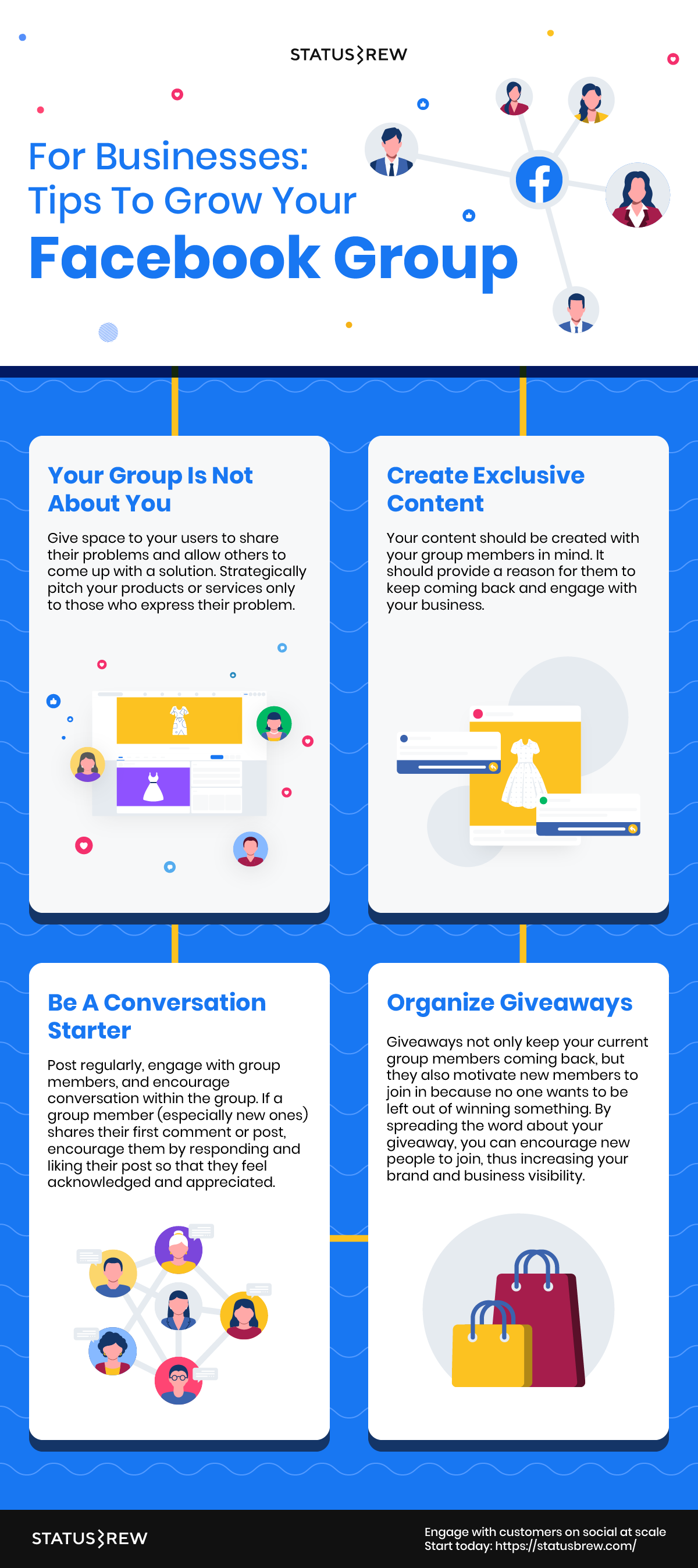
Citation Policy: Please feel free to use these infographics in any commercial or non-commercial capacity. If you use the infographics, we require a reference back to Statusbrew Blog.

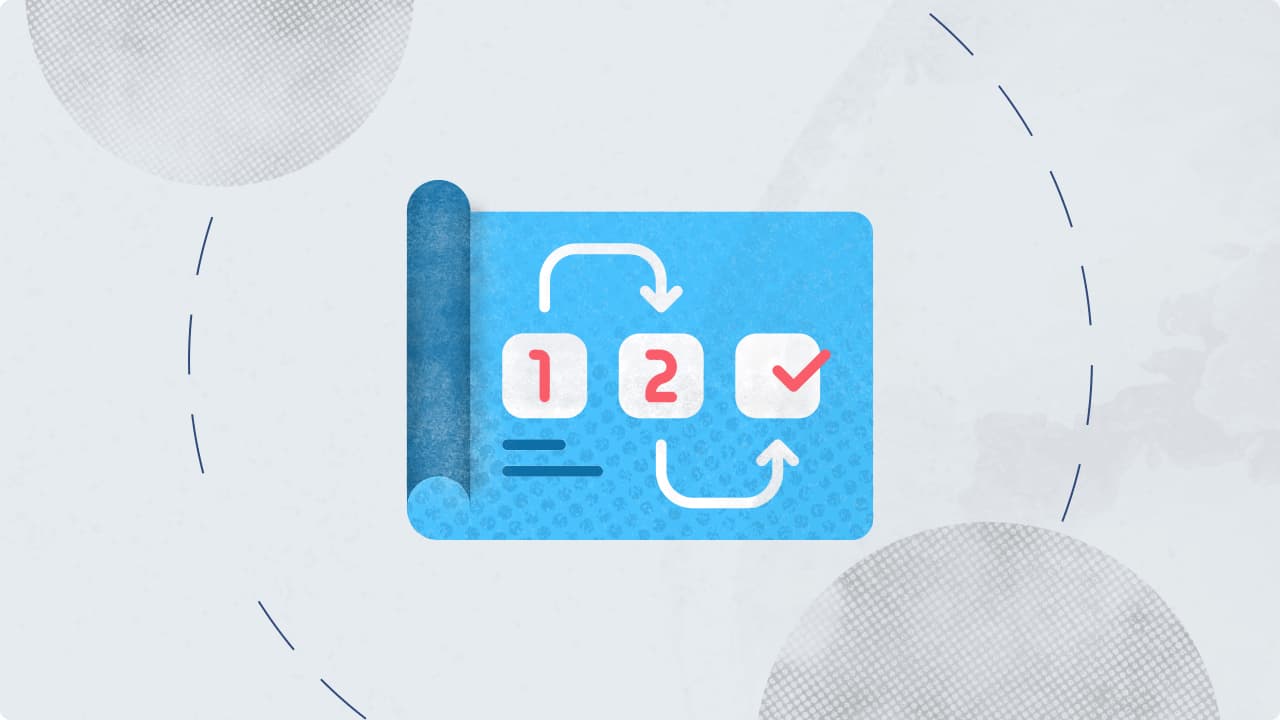
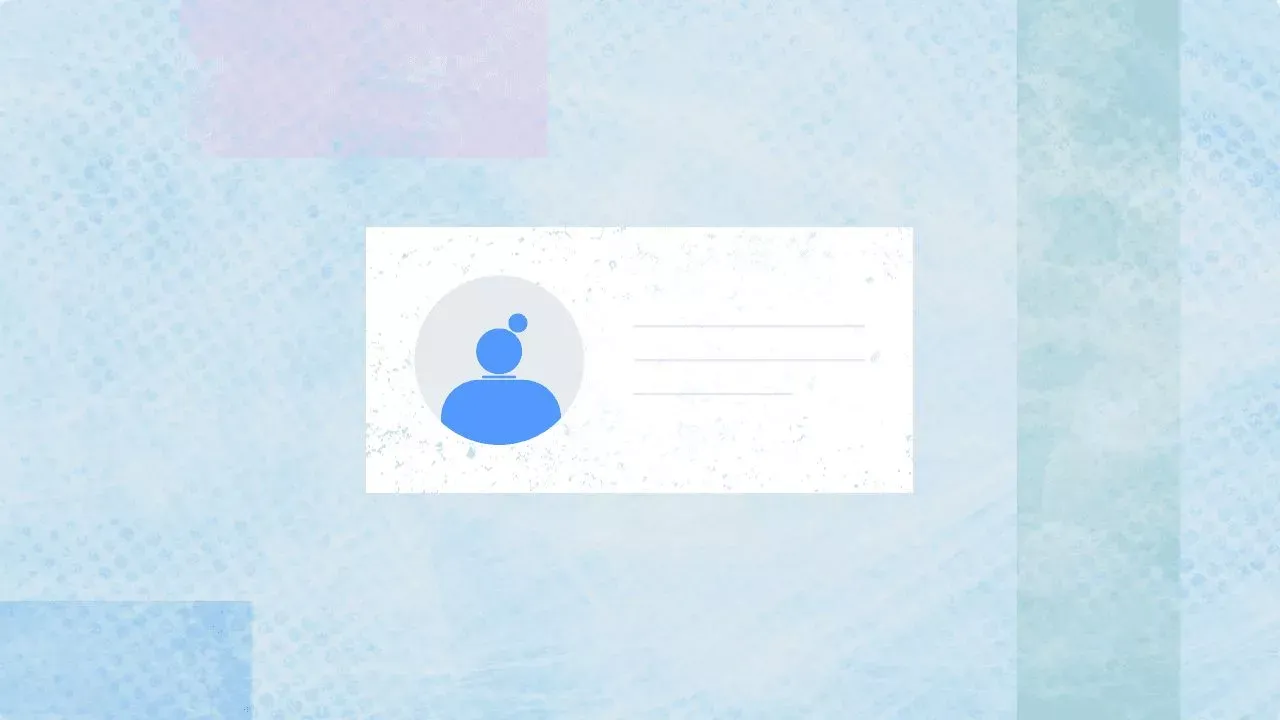
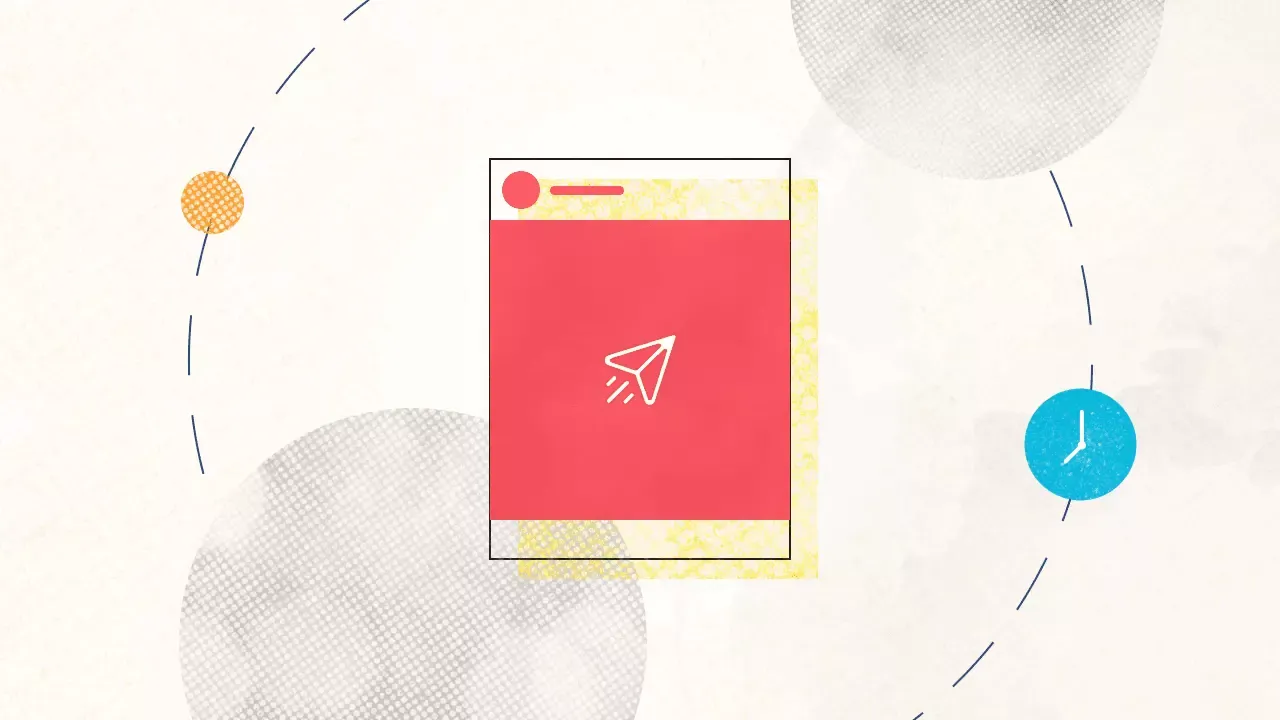
Explore the Statusbrew range of social media tools
Cancel anytime!